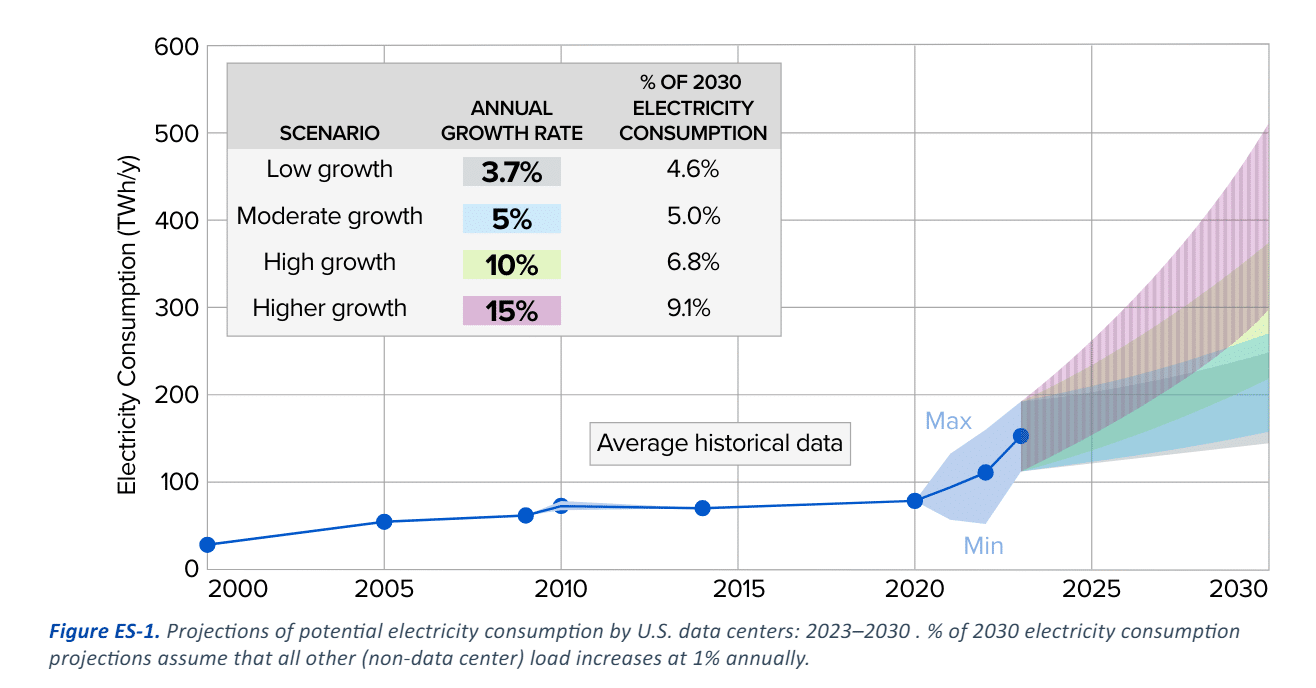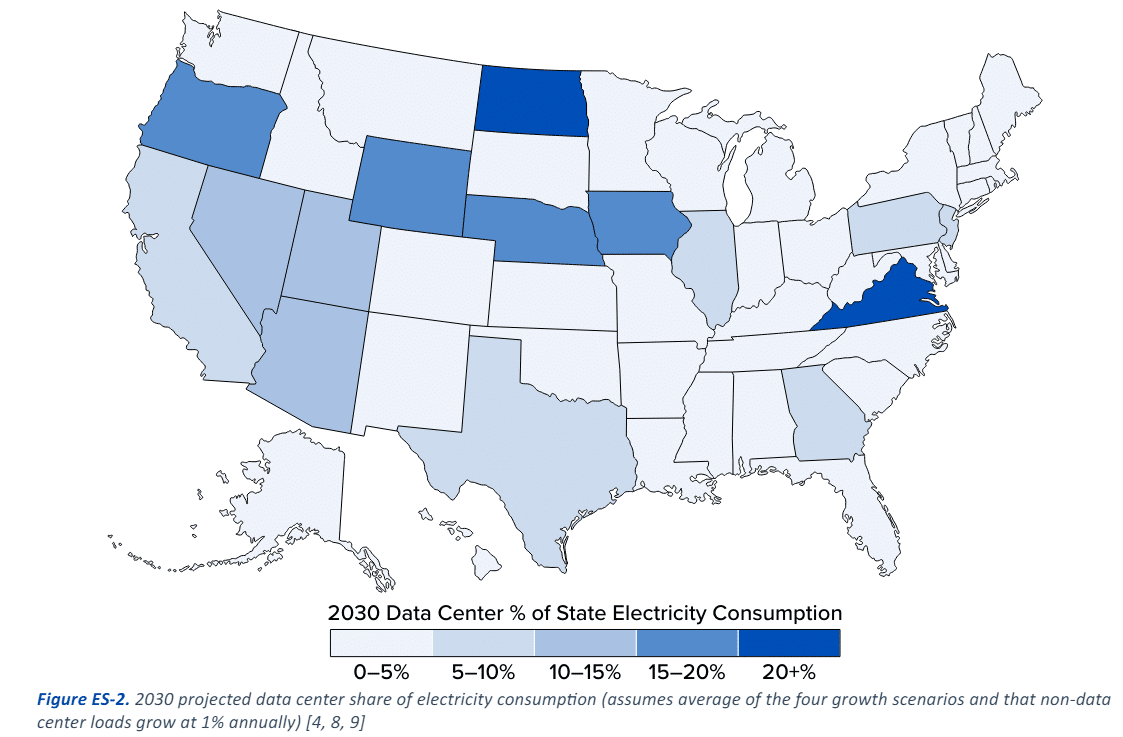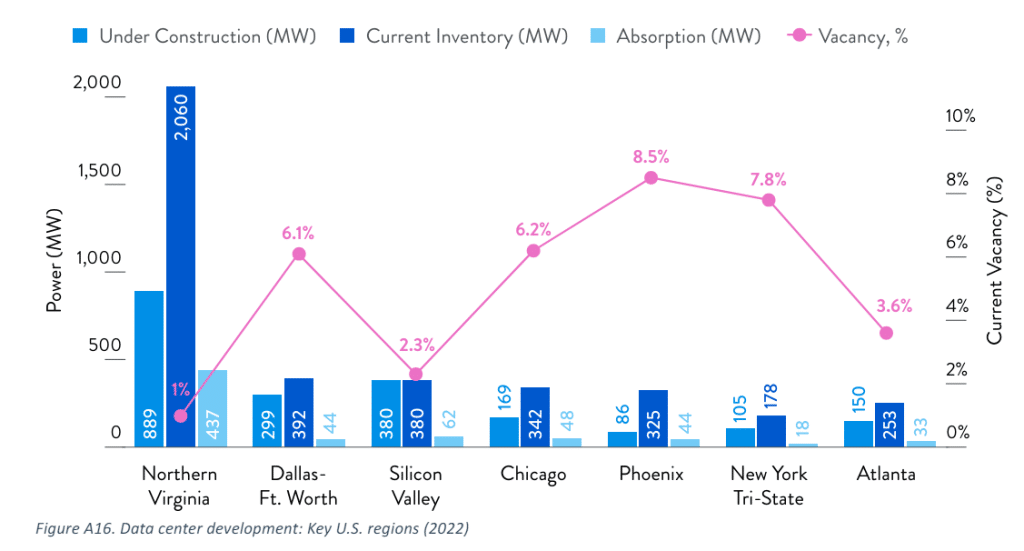Amid the energy transition, data centers play a pivotal role as greedy consumers of electricity, driving demand and shaping the future of power generation and distribution.
Data centers could consume between 4.6% and 9.1% of US electricity by 2030, according to an analysis by the Electric Power Research Institute (EPRI).
The EPRI white paper “Powering Intelligence: Analyzing Artificial Intelligence and Data Center Energy Consumption” outlines four data center electricity consumption growth scenarios from 2023 to 2030.
Continuous Operation and Rising Demand
Data centers operate continuously, requiring substantial power to support their systems and equipment. The power consumption in data centers is typically divided between IT equipment and infrastructure resources like cooling and power conditioning systems.
In 2023, global data centers consumed 7.4 GW of power, marking a 55% increase from 4.9 GW in 2022, according to a separate report by Cushman & Wakefield. This significant rise underscores the substantial environmental impact associated with the energy demands of data centers.
U.S. data center load could grow to nearly 21 GW this year, up from 19 GW in 2023, according to a Federal Energy Regulatory Commission (FERC) report. By the end of the decade, this electricity demand will climb to 35 GW, according to the FERC.
Currently, data centers account for over 4% of the total US electricity load but could rise to 9% by 2030. This growth is due to increasing computing power needed by artificial intelligence (AI).
AI queries needs about 10x the power use of traditional internet searches, while generating AI-made music, photos, and videos requires much more.
- A traditional Google search uses about 0.3 watt-hours (Wh), while a query using ChatGPT, the chatbot developed by OpenAI, requires around 2.9 Wh, EPRI reported.
The International Energy Agency predicts US data center electricity consumption will rise from 200 TWh in 2022 to about 260 TWh by 2026, making up 6% of total power demand. Boston Consulting Group projects this could reach 7.5% by 2030.
EPRI’s Four Datacenter Energy Consumption Scenarios
The EPRI report analyzes the future energy consumption of power-hungry data centers under four scenarios.
In a low-growth scenario, data centers’ electricity consumption would grow by 3.7% annually, reaching 4.6% by 2030. This is primarily driven by limited AI tool adoption and significant efficiency gains.
A moderate-growth scenario predicts a 5% annual growth rate, resulting in data centers consuming 5% of US electricity. Meanwhile, high-growth scenarios foresee annual growth rates of 10% and 15%, with data centers consuming 6.8% to 9.1% of the nation’s electricity by 2030. The highest growth scenario is based on rapid AI adoption and limited efficiency improvements.
EPRI U.S. Data Center Load Projections

 EPRI emphasizes three key strategies to manage this growth, which are:
EPRI emphasizes three key strategies to manage this growth, which are:
- Enhancing data center efficiency and flexibility,
- Improving coordination between data center developers and electricity providers, and
- Developing stronger modeling tools to plan long-term grid investments.
These measures aim to support technological advancements while ensuring grid reliability and minimizing impacts on customers.
Regional Power Challenges and Strategic Planning
As of March, the Electric Power Research Institute reported 10,655 data centers worldwide, with approximately half located in the US. In 2023, about 80% of US data center load was concentrated in 15 states, led by Virginia and Texas.


EPRI highlighted the challenges posed by data centers’ demands for highly reliable power, requests for new non-emitting generation sources, and short lead times for connection (two years or less), which can strain local and regional electricity supplies.
Data centers consumed roughly a quarter of Virginia’s electricity in 2023, the highest in the US, followed by North Dakota at over 15%, and Iowa, Nebraska, and Oregon each exceeding 11%.
EPRI projected that with evenly distributed growth, Virginia’s data center load share could rise to nearly 50% in a high-growth scenario and average 36% across four scenarios. In other states, the data center load share could approach 20% or more, although actual growth could be unevenly distributed.
Hyperscalers and colocation centers dominate the US datacenter landscape, with significant growth projected in regions like Dallas-Fort Worth, Silicon Valley, Chicago, New York Tri-State, and Atlanta, potentially increasing power demands by 50% or more.
Data Center Capacities by Metropolitan Area


Utilities across the US are recognizing both the opportunities and challenges posed by data center development, especially regarding load growth and generation investments.
Indeed, analysts anticipated that data center power demand fuels U.S. utility Q1 2024 earnings discussions.
EPRI findings underscore the critical need for strategic planning and infrastructure development to accommodate the increasing energy demands of data centers while ensuring grid reliability and meeting environmental goals. EPRI Vice President of Electrification and Sustainable Energy Strategy David Porter remarked that:
“The data center boom requires closer collaboration between large data center owners and developers, utilities, government, and other stakeholders to ensure that we can power the needs of AI while maintaining reliable, affordable power to all customers.”
- SEO Powered Content & PR Distribution. Get Amplified Today.
- PlatoData.Network Vertical Generative Ai. Empower Yourself. Access Here.
- PlatoAiStream. Web3 Intelligence. Knowledge Amplified. Access Here.
- PlatoESG. Carbon, CleanTech, Energy, Environment, Solar, Waste Management. Access Here.
- PlatoHealth. Biotech and Clinical Trials Intelligence. Access Here.
- Source: https://carboncredits.com/us-data-centers-power-requirement-will-double-by-2030/
